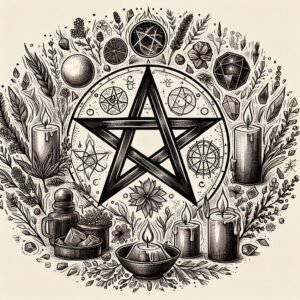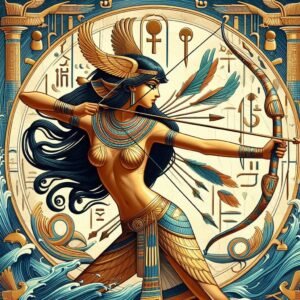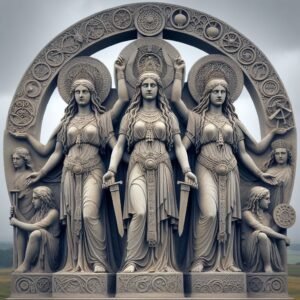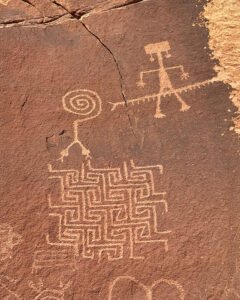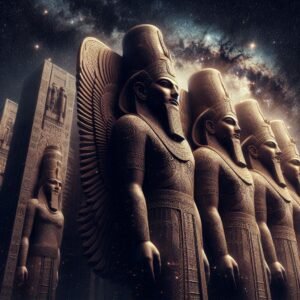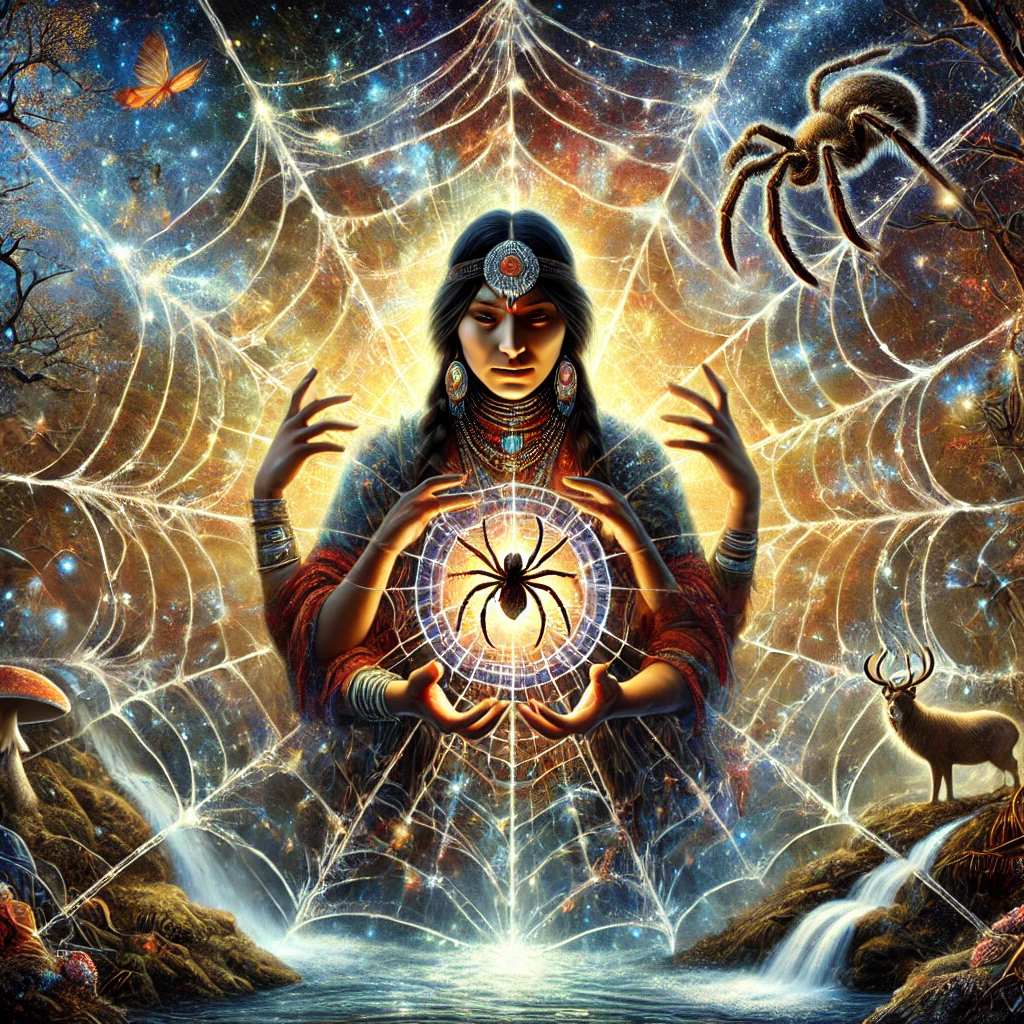
Across various cultures, the divine feminine has been revered as a transformative force, embodying both nurturing and creative aspects of existence. In Native American mythology, one prominent figure that represents this divine feminine is the Spider Queen, a powerful archetype of creation, wisdom, and connection. The Spider Queen, or Spider Woman, plays a pivotal role in several Native American traditions, acting as both a creator deity and a protector. Her presence is tied to the balance of nature and the harmony of the universe, yet the feminine energy she embodies is often misunderstood and suppressed, leading to psychological and emotional struggles for those who channel it. The concept of the Spider Queen, and the women who align with her archetype, reveals deeper insights into both mythological symbolism and the marginalization of feminine power in society.
The Spider Queen in Native American Mythology
In the myths of many Native American tribes, the Spider Queen is an essential figure, often depicted as a creator deity. One of the most famous representations comes from the Hopi tribe, where Spider Woman is regarded as a creator who taught humanity essential skills. According to Hopi mythology, Spider Woman created the world, weaving it from the threads of the universe. She also taught the people how to make use of the resources of the earth, such as weaving and pottery. She is revered as a mother figure, deeply connected to the earth, and symbolizing the interconnectedness of all living things. In this sense, Spider Woman is not just a creator but a protector, ensuring that the delicate balance of life is maintained.
The Navajo also have a rich tradition surrounding Spider Woman. In their stories, Spider Woman is associated with the creation of the world and the preservation of life through her weaving. The Navajo believe that Spider Woman helped the Holy People weave the first tapestry of existence, and her web connects the earth, the heavens, and the underworld. Her webs are said to represent the interconnectedness of all things, symbolizing the balance and harmony necessary for life to flourish. This weaving of the world reflects the divine feminine’s power to unite, create, and protect the web of life.
The Cherokee have a similar mythological figure known as Arachne, who is sometimes associated with Spider Woman. Arachne, like other Spider Woman figures, is credited with creating the first web of life. In some Cherokee versions of the myth, Spider Woman also acts as a healer, using her knowledge of the natural world to restore balance and health to the people. As a figure tied to both wisdom and healing, Arachne embodies the dynamic nature of the divine feminine, showing how it can be a force for both creation and restoration.
Symbolism of the Spider Queen: Wisdom, Truth, and Connection
The Spider Queen is not merely a deity of creation but also a guardian of wisdom and truth. Her role as the weaver of life involves not only physical creation but also the weaving together of spiritual truths. The web of life she spins symbolizes the interconnection of all beings, acting as a spiritual network that holds the universe together. Each strand of her web represents a unique truth, and when all the threads are combined, they form a greater understanding of existence. This metaphor illustrates the wisdom of the Spider Queen, as she embodies the power to see the entire picture—each thread integral to the whole.
As the creator of both the tangible and intangible aspects of the world, the Spider Queen is often seen as a dynamic, nurturing force. She is not static in her role but is constantly adjusting and correcting, ensuring the balance of nature is maintained. This adaptability and wisdom make her an archetype of the divine feminine, which is constantly evolving and shifting, able to nurture and guide in multiple ways. This understanding of the Spider Queen as both creator and protector aligns with the idea of the divine feminine as an integrative force, able to connect diverse elements of the natural world and bring them into harmony.
The Struggle of the Spider Women: Repression and Marginalization
While the Spider Queen archetype is powerful, the women who embody this energy—referred to as Spider Women—often face societal marginalization. These women, deeply attuned to their spiritual and intuitive wisdom, can be misunderstood or dismissed in cultures that suppress the feminine. The qualities of the Spider Queen—creativity, intuition, and wisdom—are often undervalued in patriarchal societies, leading to the repression of women who possess these traits.
The psychological impact of this repression is evident in many cultures, where women who embody the Spider Queen’s wisdom are labelled as difficult, overly emotional, or out of touch with reality. In traditional Native American societies, women were often revered for their spiritual wisdom and connection to the earth, but the influence of colonization and the rise of patriarchal norms led to the suppression of these roles. As a result, the divine feminine, represented by the Spider Queen, became marginalized, and women who embodied these qualities were often forced into the shadows.
This dynamic is not unique to Native American cultures but resonates across many belief systems that emphasize the importance of the divine feminine. In contemporary society, women who embody these qualities may still face challenges, as they navigate systems that prioritize logic, structure, and masculine energy. The repression of the divine feminine continues to have psychological and emotional consequences, and understanding the symbolism of the Spider Queen and the role of Spider Women provides valuable insight into the ways in which these struggles are rooted in both cultural and psychological patterns.
Parallels in Other Mythologies: The Divine Feminine Under Attack
The Spider Queen and her role in Native American mythology has strong parallels with the divine feminine figures found in other global belief systems. In many ancient cultures, the feminine was deeply connected with creation, nurturing, and the balance of the world. From the Goddess of the Earth in pre-Christian Europe to Tiamat in Mesopotamian mythology, we see a recurring pattern of women associated with the cosmic web—weaving the fabric of life, protecting the world, and bringing balance to the divine and material realms.
However, as patriarchy began to rise, these feminine symbols were often suppressed, reshaped, or diminished in their power. The divine masculine took on greater prominence, and the feminine became associated with weakness, fragility, or subordination. The transition from a matriarchal to a patriarchal worldview not only altered religious beliefs but also gendered the very nature of power in society.
The Psychological Struggle: Spider Women in Modern Society
In the context of modern life, women who embody the Spider Queen energy—those who are highly intuitive, sensitive, and attuned to the spiritual wisdom of the world—often experience deep psychological conflict. These women, whom we can refer to as Spider Women, are often misunderstood. They are perceived as overly anxious, neurotic, or out of balance with reality. This is because their ability to see the truth—especially the uncomfortable truths that others wish to avoid—can lead to social rejection.
The psychological tension for Spider Women is compounded by society’s insistence on maintaining a false sense of security and comfort. The divine feminine, in its wisdom, often speaks truth that disrupts these illusions. For example, a Spider Woman might be deeply attuned to the dangers of the world—whether they relate to environmental issues, societal structures, or the plight of the marginalized—and feel an innate drive to speak up and address these issues. Yet, society demands that these women suppress their feelings, denying the truth that they carry.
The Role of the Medical System: Perpetuating the Myth of the Fragile Woman
The medical system plays a significant role in reinforcing the myth of the fragile woman. For centuries, women have been treated as fragile beings, in need of protection and supervision, especially when it comes to their bodies and emotions. The rise of psychiatry and medicine has often framed women’s psychological struggles as pathologies to be treated rather than divine callings to engage with deeper truths. The medical system has historically been an arm of patriarchal control, systematically pathologizing the behaviours and emotions of women who don’t fit the societal norm of compliance or submissiveness.
This is why many Spider Women find themselves in a position where their divine wisdom—their connection to the spiritual truth of the world—becomes misunderstood, resulting in marginalization. Rather than being seen as spiritually empowered, these women are often treated as anxious, neurotic, or irrational, leading to a sense of isolation and disconnect from the broader community. This is not a flaw in the women themselves, but rather a flaw in the societal systems that fail to recognize and honour the divine feminine.
Society in Denial: The Root of the Problem
The core issue at play is that society is in denial. It refuses to recognize the divine feminine in its fullness—as a source of power, wisdom, and truth. Instead, society insists that women conform to a narrow, patriarchal model of what is considered acceptable or safe. By doing so, society forces Spider Women to disconnect from their divine nature, which leads to psychological conflict, alienation, and illness.
The true psychological illness here is not within the women themselves but in the societal structures that suppress their natural divine expression. When women are told to silence their truth, to deny their intuitive wisdom, and to submit to the dominant narrative, it causes an imbalance that manifests as psychological dis-ease.
The Alternative: Reclaiming the Divine Feminine
The alternative is a reclaiming of the divine feminine—recognizing it not only as a spiritual force but as a source of psychological health and empowerment. This involves creating a world where women can be truth-tellers, wise guides, and spiritual leaders without fear of rejection or being labelled as mentally ill.
It also means re-envisioning the role of women in the medical system—acknowledging their intuitive wisdom and supporting their holistic health, not as a separate or fragile entity, but as a powerful, integrated part of the cosmic order. Spider Women, as keepers of truth, can heal not only themselves but their communities when they are allowed to speak their truths and reconnect with their divine wisdom.
Conclusion: The True Path to Healing
In conclusion, the Spider Queen symbolizes the divine feminine—a powerful, creative force that is often misunderstood, suppressed, and rejected by society. Spider Women, who embody this divine energy, are often labelled as anxious, fragile, or difficult, when in reality, they are simply in touch with a deeper spiritual truth. By recognizing the spiritual and psychological value of the divine feminine and allowing women to reclaim their roles as spiritual guides, truth-tellers, and leaders, we can begin to address the root causes of the psychological issues facing these women and create a more balanced, empowered society.
When society stops denying the truth, and when women can live authentically and speak their truth, they will heal—not just themselves, but the world around them. The true healing lies in honouring and empowering the divine feminine—for when the feminine is revered, both men and women can truly heal and find their way back to balance and wholeness.
Subscribe to our post updates - Don't miss a thing!!

